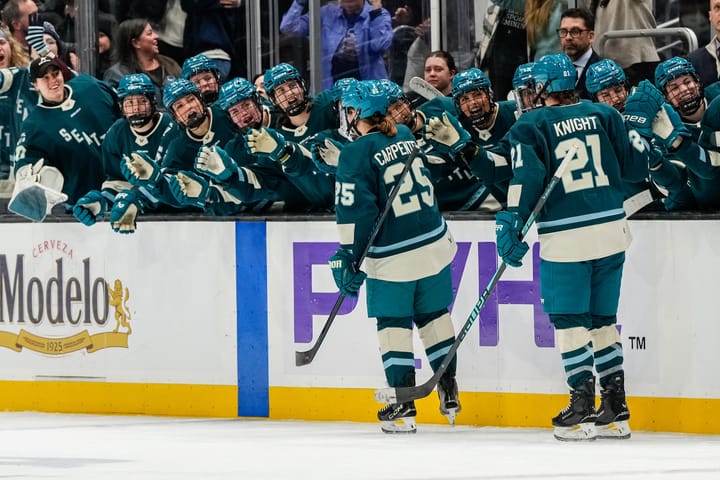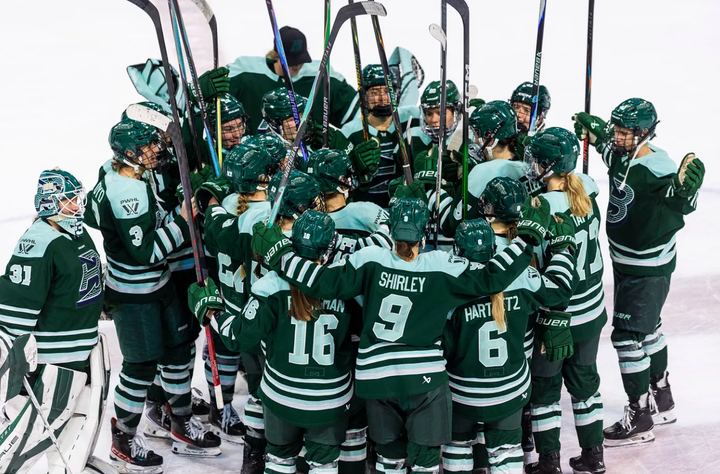Q&A with Frozen Four analyst Sonny Watrous
Former Providence College player on broadcasting for her alma mater, Big Ten Network
Sonny Watrous is a college hockey analyst who women’s hockey fans should definitely be paying attention to, if they’re not already. For the third consecutive year, she has worked as the color commentator for Big Ten Network’s Frozen Four coverage, this time being paired with play-by-play announcer Chris Vosters.
Watrous also is the primary color analyst for Providence College hockey games on both the men’s and women’s side. The 2007 graduate of Providence played for the Friars for four years, finishing her career with 67 goals and 137 points in 137 games. The Ice Garden caught up with her before the semifinal games to discuss her career as a broadcaster and her future goals in the field.
TIG: You went to Providence College and played hockey there. Unfortunately, that was before the pro options were really available. What got you into broadcasting?
SW: Kind of a funny story. [Providence’s] goaltending coach at the time, Bob Bellemore, he would always be commentating with us when we were waiting in line to do a drill. It was my junior year, and I was just pretending to do play-by-play on every single drill that came down, just to pass the time, and he said, “You should get into broadcasting,” and I said, “Really? You think so?” and he said, “Yeah, absolutely.”
At the time, that wasn’t even something that was on my radar, but I said, “You know what? I’ll give it a try,” so I interned with a local news station, and then just started, you know, wherever I could meet somebody, I always made myself available, to start off by sideline reporting, because ultimately, once I got into it I knew I wanted to get into doing color commentary. It just happened over time. But really, thanks to Bob Bellemore. He heard something and went with it.
TIG: What else have you done? Have you done more than just hockey?
SW: Yep, so hockey’s really my wheelhouse, being a former player, and I love the game, love still having a game day. I’ve done some sideline for football, mainly college — Ivy League. I got to spend a summer doing the Cape Cod Baseball League, doing sideline again, but this is going to be my third year covering the Women’s Frozen Four championship.
TIG: Where else have you worked before?
SW: Mainly Providence, men’s and women’s [hockey], and then with the Big Ten Network I picked up a couple games here and there. This is actually my side job; I work full-time for Blue Cross Blue Shield of Rhode Island. But again, I get to have a game day still.
TIG: What do you think your favorite part of working on broadcasts is?
SW: Watching the players and being able to project the excitement that they have. You see it come through when they score a big goal and having been in that position before, being able to help bring that to light and being able to put a spotlight on these athletes that have worked so hard, and I always think about their parents that are watching the game too. I know my parents, being in New Mexico, couldn’t get to a lot of my games, so they relied upon the radio calls, and now a lot of these games are streaming online, so even if a network doesn’t pick them up, a lot of parents can still watch the games.
TIG: How did you land the Big Ten Network Frozen Four job?
SW: I’m not really sure, actually. Three years ago, I had made myself available to do the selection show with the NCAA. Like I said, I’ve been doing the men’s and women’s Hockey East championship games for a while and started to build some relationships, and got a phone call asking if I could be available. I had a three-month-old baby at home, and on the phone, I didn’t know how that was gonna happen, but thankfully the Big Ten Network team was really supportive and we were able to all go, and from there, every year I was thankfully asked to do it again.
TIG: You do men’s as well as women’s games for Providence. What do you think the similarities and differences are between working the two?
SW: There are probably more similarities than folks think, I think probably the most glaring difference is just there’s not as many big hits. I say there’s not as many big hits because even in the women’s game, you still see a lot of really big hits. That’s probably the only difference and I just have to adjust my mindset that, “Okay, this is definitely going to be a penalty,” versus just part of the normal game.
TIG: Do you have any ultimate goals in broadcasting or do you think this is it?
SW: I feel so lucky to be here calling an NCAA tournament. When I was a player, we made it to the quarterfinals my sophomore year, so I never got to be in this type of setting. I would love to be able to one day maybe call for an NHL team, I would love to just continue to find different avenues. Maybe the Olympics—the challenge there is there are so many great Olympians that are really good in this area as well, and I don’t have that [playing] experience under my belt—but definitely continuing to be able to come back to this type of setting.





Comments ()